
Concept explainers
(a)
Evaluate
(a)
Answer to Problem 54RE
At x = 1:
Explanation of Solution
Given information:
The graph of a function f :
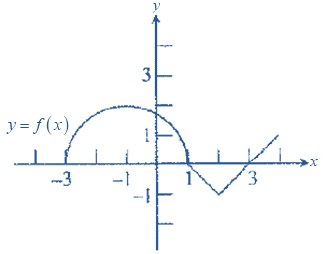
Calculation:
We have
At
By evaluating the integral:
Therefore,
(b)
Evaluate
(b)
Answer to Problem 54RE
At
Explanation of Solution
Given information:
The graph of a function f :
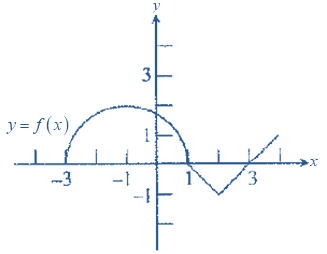
Calculation:
Since
Then
The area of the graph between 1 and 3 is a triangle below the x − axis.
Thus,
It has a negative area.
That includes
Base of 2 and Height of 1.
Then
The area:
(c)
Evaluate
(c)
Answer to Problem 54RE
At
Explanation of Solution
Given information:
The graph of a function f :
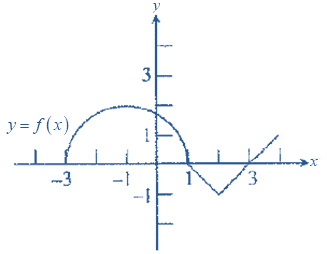
Calculation:
We have
Substitute
To switch the bounds, use the Order of Integration rule:
The region from
Then
Use the formula for the area of the quarter circle:
Therefore,
(d)
All values of x on the open interval [-3, 4] at which g has a
(d)
Answer to Problem 54RE
Explanation of Solution
Given information:
The graph of a function f :
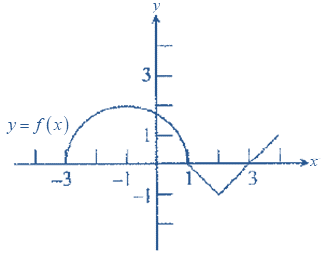
Calculation:
To know where
Since
According to FTC:
Then
And
Therefore,
(e)
Equation for the line tangent to the graph of g at
(e)
Answer to Problem 54RE
Linear function:
Explanation of Solution
Given information:
The graph of a function f :
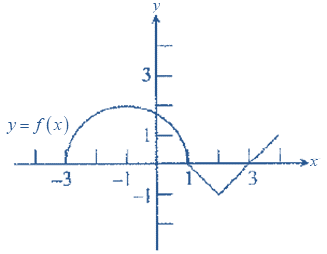
Calculation:
The slope of linear function:
From Part (c) result,
We have
Then
The Linear function:
Rewrite the above equation:
Therefore,
(f)
x − coordinate of each point of inflection of the graph of g at
(f)
Answer to Problem 54RE
x − coordinates of the points of inflection:
Explanation of Solution
Given information:
The graph of a function f :
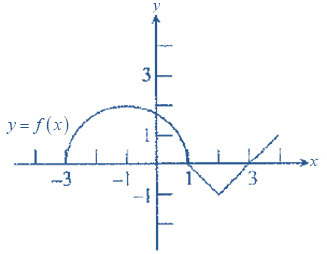
Calculation:
The points of inflection of g occur at x − values.
Such that
Since
Then
That further becomes
Therefore,
The values of x that make
From the graph of f ,
The slope of f is 0 at
Thus,
And
The slope of f is undefined at
Thus,
f’ switches from positive to negative at
Then
f’ is negative to the left and right of
Then
f’ switches from negative to positive at
Therefore,
The x − coordinates of the points of inflection are
(g)
Range of g
(g)
Answer to Problem 54RE
The range is [
Explanation of Solution
Given information:
The graph of a function f :
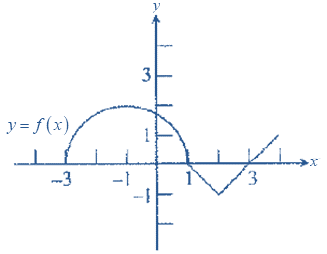
Calculation:
In order to obtain the range of g ,
We are required to find the absolute minimum absolute maximum of g .
To obtain absolute extremes,
We are required to find the critical values and evaluate those critical values and endpoints in the original function to know which gives the largest value and which gives the least.
Since
Then
From the graph,
At
And
At the endpoints:
At
At
At
At
Therefore,
Absolute minimum is
And
Absolute maximum is 0.
Then
The range is [
Chapter 6 Solutions
Calculus 2012 Student Edition (by Finney/Demana/Waits/Kennedy)
Additional Math Textbook Solutions
Basic Business Statistics, Student Value Edition
Elementary Statistics: Picturing the World (7th Edition)
Calculus: Early Transcendentals (2nd Edition)
A First Course in Probability (10th Edition)
A Problem Solving Approach To Mathematics For Elementary School Teachers (13th Edition)
Elementary Statistics
- For each graph in Figure 16, determine whether f (1) is larger or smaller than the slope of the secant line between x = 1 and x = 1 + h for h > 0. Explain your reasoningarrow_forwardPoints z1 and z2 are shown on the graph.z1 is at (4 real,6 imaginary), z2 is at (-5 real, 2 imaginary)Part A: Identify the points in standard form and find the distance between them.Part B: Give the complex conjugate of z2 and explain how to find it geometrically.Part C: Find z2 − z1 geometrically and explain your steps.arrow_forwardA polar curve is represented by the equation r1 = 7 + 4cos θ.Part A: What type of limaçon is this curve? Justify your answer using the constants in the equation.Part B: Is the curve symmetrical to the polar axis or the line θ = pi/2 Justify your answer algebraically.Part C: What are the two main differences between the graphs of r1 = 7 + 4cos θ and r2 = 4 + 4cos θ?arrow_forward
- A curve, described by x2 + y2 + 8x = 0, has a point A at (−4, 4) on the curve.Part A: What are the polar coordinates of A? Give an exact answer.Part B: What is the polar form of the equation? What type of polar curve is this?Part C: What is the directed distance when Ø = 5pi/6 Give an exact answer.arrow_forwardNew folder 10. Find the area enclosed by the loop of the curve (1- t², t-t³)arrow_forward1. Graph and find the corresponding Cartesian equation for: t X== y = t +1 2 te(-∞, ∞) 42,369 I APR 27 F5 3 MacBook Air stv A Aa T 4 DIIarrow_forward
- Middle School GP... Echo home (1) Addition and su... Google Docs Netflix Netflix New folder 9. Find the area enclosed by x = sin²t, y = cost and the y-axis.arrow_forward2. Graph and find the corresponding Cartesian equation for: (4 cos 0,9 sin 0) θ ε [0, 2π) 42,369 I APR 27 3 MacBook Air 2 tv A Aaarrow_forward30 Page< 3. Find the equation of the tangent line for x = 1+12, y = 1-3 at t = 2 42,369 APR A 27 M . tv NA 1 TAGN 2 Aa 7 MacBook Air #8arrow_forward
 Calculus: Early TranscendentalsCalculusISBN:9781285741550Author:James StewartPublisher:Cengage Learning
Calculus: Early TranscendentalsCalculusISBN:9781285741550Author:James StewartPublisher:Cengage Learning Thomas' Calculus (14th Edition)CalculusISBN:9780134438986Author:Joel R. Hass, Christopher E. Heil, Maurice D. WeirPublisher:PEARSON
Thomas' Calculus (14th Edition)CalculusISBN:9780134438986Author:Joel R. Hass, Christopher E. Heil, Maurice D. WeirPublisher:PEARSON Calculus: Early Transcendentals (3rd Edition)CalculusISBN:9780134763644Author:William L. Briggs, Lyle Cochran, Bernard Gillett, Eric SchulzPublisher:PEARSON
Calculus: Early Transcendentals (3rd Edition)CalculusISBN:9780134763644Author:William L. Briggs, Lyle Cochran, Bernard Gillett, Eric SchulzPublisher:PEARSON Calculus: Early TranscendentalsCalculusISBN:9781319050740Author:Jon Rogawski, Colin Adams, Robert FranzosaPublisher:W. H. Freeman
Calculus: Early TranscendentalsCalculusISBN:9781319050740Author:Jon Rogawski, Colin Adams, Robert FranzosaPublisher:W. H. Freeman
 Calculus: Early Transcendental FunctionsCalculusISBN:9781337552516Author:Ron Larson, Bruce H. EdwardsPublisher:Cengage Learning
Calculus: Early Transcendental FunctionsCalculusISBN:9781337552516Author:Ron Larson, Bruce H. EdwardsPublisher:Cengage Learning





